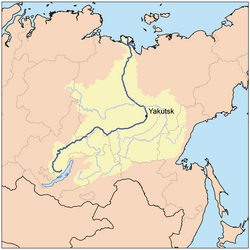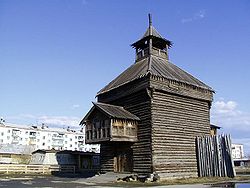Yakutsk
| Yakutsk (English) Якутск (Russian) Дьокуускай (Sakha) |
|
|---|---|
| — Inhabited locality — | |
.jpg) View of the city from the Geological Institute collections area |
|
 Location of Yakutsk in the Lena watershed |
|
| Coordinates: | |
 |
 |
| Holiday | Second Sunday of September |
| Administrative status | |
| Country | Russia |
| Federal subject | Sakha Republic |
| Capital of | Sakha Republic |
| Municipal status (as of March 2008) | |
| Head | Yury Zabolev |
| Representative body | Okrug Council |
| Statistics | |
| Area | 121.93 km2 (47.08 sq mi) |
| Population (2002 Census) | 210,642 inhabitants[1] |
| - Rank | 89th |
| - Density | 1,728 /km2 (4,480 /sq mi)[2] |
| Founded | 25 September 1632 |
| Postal code(s) | 677xxx |
| Dialing code(s) | +7 4112 |
| Official website | |
Yakutsk (Russian: Яку́тск; Sakha: Дьокуускай, D'okuuskaj pronounced [ɟokuːskaj]) is a city in the Russian Far East, located about 4° (450 kilometres) south of the Arctic Circle. It is the capital of the Sakha (Yakutia) Republic (formerly the Yakut Autonomous Soviet Socialist Republic), Russia and a major port on the Lena River. It is served by Yakutsk Airport as well as the smaller Magan Airport. The city has a population of 210,642 (2002 Census);[1] 186,626 (1989 Census).[3]
Contents |
History
Yakutsk was founded as an ostrog (fort) by Pyotr Beketov in 1632. In 1639 it became the center of a Voyevodstvo. The Voyevoda of Yakutsk quickly became the most important Russian official in eastern Siberia and directed expansion to the east and south. Yakutsk did not grow into a city until the discovery of large reserves of gold and other minerals in the 1880s and 1890s. These reserves were developed extensively during the industrialization under Stalin. The rapid growth of forced labor camps in Siberia was also a major factor encouraging Yakutsk's development.
Transport
Yakutsk is a destination of the Lena Highway. The city's connection to the highway is only accessible by ferry in the summer, or in the dead of winter, directly over the frozen Lena River, as Yakutsk lies entirely on its western bank, and there is no bridge anywhere in the Sakha Republic that crosses the Lena. The river is impassable for long periods of the year when it is full of loose ice, or when the ice cover is not sufficiently thick to support traffic, or when the water level is high and the river turbulent with spring flooding. The highway ends on the eastern bank of Lena in Nizhny Bestyakh (Нижний Бестях), an urban-type settlement of some four thousand people. Yakutsk is connected with Magadan in by the Kolyma Highway.
A dual-use railroad and roadway bridge over the Lena is scheduled to be built by 2013[4][5], when the Amur Yakutsk Mainline, the North-South railroad being extended from the South, will finally connect the city with the East-West Baikal Amur Mainline (the railway has reached a point some 260 km south of Yakutsk).
The bridge will be over 3 kilometers long and constructed 40 km upriver at Tabaga, where the river narrows and does not create a wide flooded area in spring. In the dead of winter, the frozen Lena makes for a passable highway for ice truckers using its channel to deliver provisions to far-flung outposts. Yakutsk is also connected to other parts of Russia by the Yakutsk Airport.
Education
Yakutsk State University is situated in the city. There is also a branch of the Russian Academy of Sciences, which contains, among other things, the Institute of Cosmophysical Research, which runs the Yakutsk Extensive Air Shower installation (one of the largest cosmic-ray detector arrays in the world), and the Permafrost Research Institute developed with the aim of solving the serious and costly problems associated with construction of buildings on frozen soil.
At the primary and secondary levels, the city has a number of UNESCO Associated Schools, including the Sakha-Turkish College, Sakha-French School, Sakha-Korean School, and School #16.[6]
Yakutsk is also home of some theaters and museums such as Sakha theater and the Museum of Mammoth.
Economy
The city has offices of many mining companies, including ALROSA, whose diamond mines in Yakutia account for about 20% of the world's rough diamond output.
The airline Yakutia Airlines has its head office in the city.[7]
Climate
| Yakutsk | ||||||||||||||||||||||||||||||||||||||||||||||||||||||||||||
|---|---|---|---|---|---|---|---|---|---|---|---|---|---|---|---|---|---|---|---|---|---|---|---|---|---|---|---|---|---|---|---|---|---|---|---|---|---|---|---|---|---|---|---|---|---|---|---|---|---|---|---|---|---|---|---|---|---|---|---|---|
| Climate chart () | ||||||||||||||||||||||||||||||||||||||||||||||||||||||||||||
|
||||||||||||||||||||||||||||||||||||||||||||||||||||||||||||
|
||||||||||||||||||||||||||||||||||||||||||||||||||||||||||||
Yakutsk is the coldest city (though not inhabited place) on Earth. Average monthly temperatures range from 19 °C (66 °F) in July to -40° in January. The coldest temperatures ever recorded on the planet outside Antarctica occurred in the basin of the Yana River to the northeast of Yakutsk. Although winters are long and extremely cold, summers are warm (though rather short), with daily maximum temperatures occasionally exceeding 32 °C (90 °F), making the seasonal temperature differences for the region among the greatest in the world. As the biggest city built on continuous permafrost, most houses in Yakutsk are built on concrete piles. The climate is semi-arid, with maximum precipitation occurring in the summer months.
With the Lena River navigable in the summer, there are various boat cruises offered, including upriver to the Lena Pillars, and downriver tours which visit spectacular scenery in the lower reaches and the Lena delta.
| Climate data for Yakutsk | |||||||||||||
|---|---|---|---|---|---|---|---|---|---|---|---|---|---|
| Month | Jan | Feb | Mar | Apr | May | Jun | Jul | Aug | Sep | Oct | Nov | Dec | Year |
| Source: Pogoda.ru.net[8] | |||||||||||||
International relations
Twin towns — Sister cities
Yakutsk is twinned with:
 Changwon, South Korea.
Changwon, South Korea. Fairbanks, Alaska, United States.
Fairbanks, Alaska, United States. Harbin, Heilongjiang, China.
Harbin, Heilongjiang, China. Murayama, Japan.
Murayama, Japan. Yellowknife, Northwest Territories, Canada.
Yellowknife, Northwest Territories, Canada.
Gallery
 |
.jpg) |
 |
 |
References
- Notes
- ↑ 1.0 1.1 Федеральная служба государственной статистики (Federal State Statistics Service) (2004-05-21). "Численность населения России, субъектов Российской Федерации в составе федеральных округов, районов, городских поселений, сельских населённых пунктов – районных центров и сельских населённых пунктов с населением 3 тысячи и более человек (Population of Russia, its federal districts, federal subjects, districts, urban localities, rural localities—administrative centers, and rural localities with population of over 3,000)" (in Russian). Всероссийская перепись населения 2002 года (All-Russia Population Census of 2002). Federal State Statistics Service. http://perepis2002.ru/ct/html/TOM_01_04_1.htm. Retrieved 2009-08-19.
- ↑ The value of density was calculated automatically by dividing the 2002 Census population by the area specified in the infobox. Please note that this value may not be accurate as the area specified in the infobox does not necessarily correspond to the area of the entity proper or is reported for the same year as the Census (2002).
- ↑ "Всесоюзная перепись населения 1989 г. Численность наличного населения союзных и автономных республик, автономных областей и округов, краёв, областей, районов, городских поселений и сёл-райцентров. (All Union Population Census of 1989. Present population of union and autonomous republics, autonomous oblasts and okrugs, krais, oblasts, districts, urban settlements, and villages serving as district administrative centers.)" (in Russian). Всесоюзная перепись населения 1989 года (All-Union Population Census of 1989). Demoscope Weekly (website of the Institute of Demographics of the State University—Higher School of Economics. 1989. http://demoscope.ru/weekly/ssp/rus89_reg.php. Retrieved 2007-12-13.
- ↑ "In 2009 construction of the Bridge through Lena River will begin", Republic of Sakha Information Portal, 29 March 2007, reprint of an article by Aleksey Dmitriev in the newspaper “Yakutia”. Link accessed 2008-01-13. (English) (Russian)
- ↑ Russia Basel's wins tender to build Yakutia railroad Reuters, Thu Nov 6, 2008
- ↑ Nikolaev, Michael E. (2007-01-07). "The Most Valuable Possession of a Society is Education". Yakutia Today. http://www.yakutiatoday.com/region/education_article_nikolaev.shtml. Retrieved 2009-08-04.
- ↑ "About Us." Yakutia Airlines. Retrieved on 18 July 2010. "JSC "Air Company Yakutia" Address: 9, Bykovsky st., Yakutsk, Russia, 677014." Russian address: "Contact Us." "ОАО «Авиакомпания «Якутия» Адрес: Республика Саха (Якутия), 677014, г. Якутск, ул. Быковского, 9"
- ↑ 8.0 8.1 "Pogoda.ru.net" (in Russian). http://pogoda.ru.net/climate/24959.htm. Retrieved 8 September 2007.
External links
- First social network of Yakutsk city
- Sakha life
- Flickr photos tagged Yakutsk
- Yakutsk State University
- Lena Pillars at Natural Heritage Protection Fund
- Some photos of Yakutsk (Russian)
- Yakutsk past and present: a photo gallery at the Ministry of Construction of the Sakha Republic website (Russian)
- Yakutsk at AskYakutia.com
- Yakutsk at eYakutia - English Yakutia
|
|||||
|
|||||||||||
|
||||||||||||||